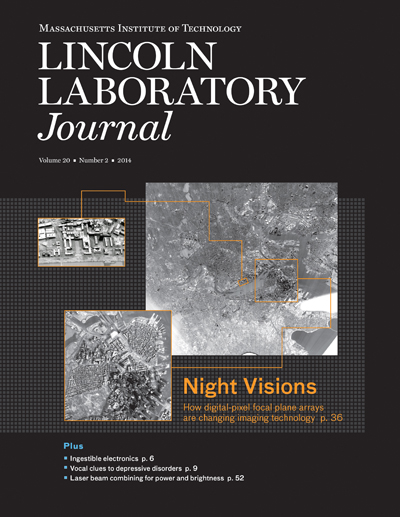Lincoln Laboratory Journal - Volume 20, Number 2

Competing Cognitive Tactical Networks
Siamak Dastangoo, Carl E. Fossa, and Youngjune L. Gwon
A cognitive-based strategy for transmission channel access addresses the need for an approach that is spectrally agile and efficient under scarce resources and that is resilient to adversarial threats. The strategy’s five key components—sensing, learning, optimizing, transmitting, and jamming—are combined to model a tactical communications network, and game-theoretic algorithms and a performance metric are employed in a hypothetical blue-force versus red-force competition for spectrum resources.
Digital-Pixel Focal Plane Array Technology
Kenneth I. Schultz, Michael W. Kelly, Justin J. Baker, Megan H. Blackwell, Matthew G. Brown, Curtis B. Colonero, Christopher L. David, Brian M. Tyrrell, and James R. Wey
Lincoln Laboratory has developed a digital-pixel focal plane array with per-pixel, 16-bit full dynamic range, analog-to-digital conversion, and real-time digital image processing capability. The technology leverages modern semiconductor processes to achieve low-power, high-component-density designs. Infrared sensors based on this innovative technology are enabling very-wide-area, high-resolution, high-sensitivity, high-update-rate imaging, as well as novel sensing modalities.
Wavelength Beam Combining for Power and Brightness Scaling of Laser Systems
Antonio Sanchez-Rubio, Tso Yee Fan, Steven J. Augst, Anish K. Goyal, Kevin J. Creedon, Juliet T. Gopinath, Vincenzo Daneu, Bien Chann, and Robin Huang
Wavelength beam combining allows for scaling the power of a laser system in a modular approach while preserving the quality of the combined beam. Lincoln Laboratory has demonstrated a wavelength-beam-combining technique that significantly improves the brightness and intensity achieved by diode laser systems. This technology could lead to diode lasers’ replacing other types of lasers in industrial applications such as metal cutting and welding.
LLCySA: Making Sense of Cyberspace
Scott M. Sawyer, Tamara H. Yu, Matthew L. Hubbell, and B. David O’Gwynn
Today’s enterprises require new network monitoring systems to detect and mitigate advanced cyber threats. The Lincoln Laboratory Cyber Situational Awareness (LLCySA) system gives network operators insights into the current state of an enterprise-scale network and provides cyber analytics researchers a platform for algorithm development. LLCySA includes highly scalable data warehousing, real-time data ingestion, responsive querying for both human users and automated analytics, and the computational capabilities required by advanced algorithms.
Lab Notes
- Load-Sensing Boots › Instrumented footwear technologies present new possibilities for tracking and preventing lower-limb musculoskeletal injuries.
- Ingestible Biosensors › An electronic "pill" could optimize physiological status monitoring.
- Beyond What the Words Say › Vocal features may predict the severity of depressive disorders.
- It's All in the Design › An exercise in visual analytics informs the approach for developing future usable network monitoring interfaces.
Looking Back
- Evolutionary Radar—Sensing for Survival › Lincoln Laboratory investigators tracked down an intriguing sensor whose performance was postulated to be much better than that of our nation's 1960s-era radars.